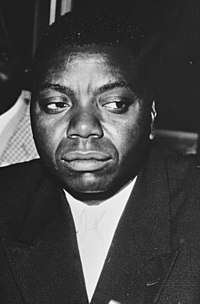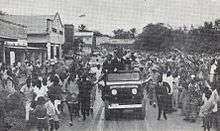Moïse Tshombe
| Moïse Tshombe | |
|---|---|
 Moïse Tshombe seated at the Belgo-Congolese Round Table Conference, January 1960 | |
| Prime Minister of the Democratic Republic of the Congo | |
|
In office 10 July 1964 – 13 October 1965 | |
| President | Joseph Kasa-Vubu |
| Preceded by | Cyrille Adoula |
| Succeeded by | Évariste Kimba |
| Personal details | |
| Born |
10 November 1919 Musumba, Belgian Congo (Now Congo-Kinshasa) |
| Died |
29 June 1969 (aged 49) Algiers, Algeria |
| Political party | CONAKAT |
Moïse Kapenda Tshombe (sometimes written Tshombé) (10 November 1919 – 29 June 1969) was a Congolese businessman and politician. He served as the president of the secessionist State of Katanga from 1960 to 1963 and as prime minister of the Democratic Republic of the Congo from 1964 to 1965.
Early life
A member of the Lunda tribes, Tshombe was born near Musumba, Belgian Congo, the son of a successful businessman. He received his education from an American missionary school and later trained as an accountant. In the 1950s, he took over a chain of stores in Katanga Province and became involved in politics.
Political career
He founded the Confédération des associations tribales du Katanga (CONAKAT) party, with Godefroid Munongo. CONAKAT promoted a federal Congo independent of the Belgian colonial empire.[1]
CONAKAT won control of the Katanga provincial legislature in the May 1960 general elections. One month later, the Congo became an independent republic. Tshombe became President of Katanga.[2]
In the resulting strife and chaos following independence, CONAKAT declared the State of Katanga's secession from the rest of the Congo. The Christian, anti-communist pro-Western Tshombe declared, "We are seceding from chaos." Favoring continued ties with Belgium, he asked the Belgian government to send military officers to recruit and train a Katangese army.
Independence leader

Tshombe demanded UN recognition for independent Katanga, and he announced that any intervention by UN troops would be met with force.[3] Nonetheless, Congolese Prime Minister Patrice Lumumba and his successor, Cyrille Adoula, successfully requested intervention from UN forces. UN forces were sent under the direction of UN Secretary-General Dag Hammarskjöld.
Lumumba's government was overthrown, and Lumumba taken prisoner by Mobutu and detained at Camp Hardy in Thysville. Harold d'Aspremont Lynden (Belgian minister for African Affairs) sent a highly confidential telegram on 16 January 1961 to the government in Léopoldville (President Joseph Kasa-Vubu and Mobutu) to send Lumumba to Katanga. That would have stemmed from Lumumba's increasing popularity among soldiers, who might release him. Meanwhile, soldier mutinies and unrest increased by the day, at Prison Camp Hardy in Thysville. The telegram has still not been shown to exist.
While being flown in a Sabena DC-4 air plane to Katanga, Lumumba was beaten by the Congolese soldiers escorting him. In custody in Katanga, Lumumba was visited by Katangese notables and Belgian officers, who included Tshombe, Godefroid Munongo, Kibwe, Kitenge, Grandelet, Son, Gat, Huyghé, Tignée, Verscheure, Segers and Rougefort. Lumumba's execution was carried out by a firing squad led by a Belgian mercenary, Julien Gat.[4]
Later life

In 1963, UN forces succeeded in suppressing Katanga, driving Tshombe into exile in Northern Rhodesia, later to Spain. In July 1964, he returned to the Congo to serve as prime minister in a new coalition government. Scarcely a year later, he was dismissed from his position in October 1965 by President Kasa-Vubu. In late 1965, General Mobutu, who had staged a successful coup against Kasa-Vubu, brought charges of treason against Tshombe, who again fled the country and settled in Francoist Spain.
In 1967, he was sentenced to death in absentia. On 30 June 1967, he was in a Hawker Siddeley jet aircraft that was hijacked by Francis Bodenan, an agent of the SDECE of France. According to the Congolese government, Tshombe was going to Africa.[5]
Tshombe was taken to Algeria, jailed, and placed under house arrest. The pilots of the plane, Britons Trevor Coppleston and David Taylor, were released and returned to the United Kingdom. The Congolese government demanded his extradition to Congo, and his Western supporters agitated for his release.[5] The Algerians resisted both demands.
Death and legacy
"Moïse Tshombe nearly became the 'savior' of the Congo on his return from exile. But history decided otherwise, and the Congolese people found themselves under the leadership of Mobutu".
Tshombe died in 1969, the official cause of death was listed as "death from heart failure". He was buried in a Methodist service at Etterbeek Cemetery, near Brussels, Belgium.[7] Due to his role in the death of Lumumba and association with Western interests, Tshombe's surname became synonymous with "sellout" to black African nationalists.[8][9][lower-alpha 1]
Honours
- Knight Grand Cross of the Order of the Crown.[11]
Notes
- ↑ A derivative of Tshombe's name, chombe, was incorporated into the Shona language as a word for "sellout". Kuchomba is the verb form.[10]
Citations
- ↑ The Congo from Leopold to Kabila, Georges Nzongola-Ntalaja, 2002, ISBN 1-84277-053-5, accessed February 2009
- ↑ "Congo (Kinshasa) provinces". www.rulers.org. Retrieved 2017-09-17.
- ↑ "Katanga Premier Warns U.N. Force" (PDF). The New York Times. New York: The New York Times Company. Reuters. 21 July 1960. Retrieved 10 January 2016.
- ↑ The Assassination of Lumumba, Ludo De Witte, 2003, ISBN 1-85984-410-3
- 1 2 Gibbs, David N. (1991). The Political Economy of Third World Intervention. University of Chicago Press. pp. 152, 167–168. ISBN 0-226-29071-9.
- ↑ Kanza 1994, p. 327.
- ↑ "Tshombe is Buried in Brussels; Sons Weep at His Grave". The New York Times. New York: The New York Times Company. UPI. 6 July 1969. p. 6. Retrieved 18 January 2016.
- ↑ Sibanda 2005, p. 116.
- ↑ Fouéré 2015, p. 158.
- ↑ Pekeshe, Munhamu (15 January 2015). "Tshombe, Geneva and détente in the village". The Patriot. Retrieved 15 May 2018.
- ↑ The Cold War, 1945-1991: Leaders and other important figures in the Soviet Union, Eastern Europe, China, and the Third World/ p. 339
References
- Fouéré, Marie-Aude, ed. (2015). Remembering Julius Nyerere in Tanzania: History, Memory, Legacy (illustrated, reprint ed.). Mkuki na Nyota Publishers. ISBN 9789987753260.
- Kanza, Thomas R. (1994). The Rise and Fall of Patrice Lumumba: Conflict in the Congo (expanded ed.). Rochester, Vermont: Schenkman Books, Inc. ISBN 0-87073-901-8.
- Sibanda, Eliakim M. (2005). The Zimbabwe African People's Union, 1961-87: A Political History of Insurgency in Southern Rhodesia (illustrated ed.). Africa World Press. ISBN 9781592212767.
Further reading
- De Witte, Ludo (2003). The Assassination of Lumumba. Verso. ISBN 1-85984-410-3.
External links
| Political offices | ||
|---|---|---|
| Preceded by Cyrille Adoula |
Prime Minister of the Democratic Republic of the Congo 10 July 1964 – 13 October 1965 |
Succeeded by Évariste Kimba |